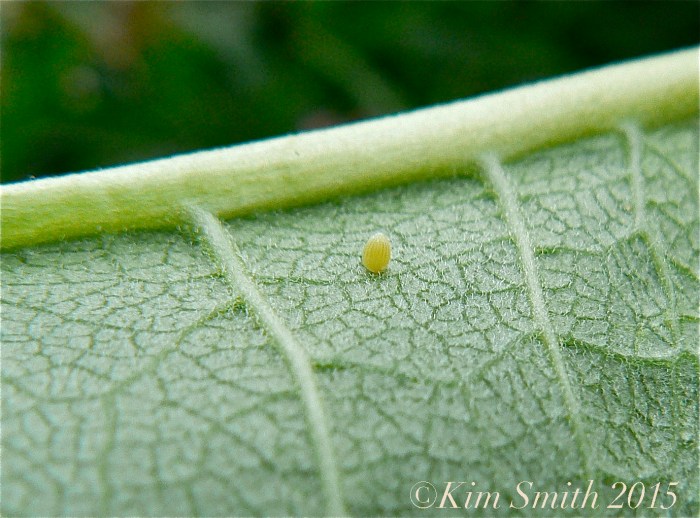 The title of the post could just as easily have read Monarchs, Eggs, and Caterpillars Here, There, and Everywhere. I haven’t seen this much Monarch activity on Cape Ann in over ten years and hope so much the number of Monarchs seen in gardens, meadows, and dunes indicates a strong migration.
The title of the post could just as easily have read Monarchs, Eggs, and Caterpillars Here, There, and Everywhere. I haven’t seen this much Monarch activity on Cape Ann in over ten years and hope so much the number of Monarchs seen in gardens, meadows, and dunes indicates a strong migration.
Thank you to everyone who has written in with your Monarch sightings! The reports are tremendously informative and fun to read, so please, do continue to let us know. The rainy cool weather has temporarily put the kibosh on mating and egg laying, but they are here on our shores and just waiting for a few warm hours and the sun to come out to renew breeding activity.
 Monarchs not only drink nectar from the florets of milkweed, it is the only species of plant on which they deposit their eggs. In the above photo you can clearly see the Monarch probing for nectar with her proboscis, or drinking straw.
Monarchs not only drink nectar from the florets of milkweed, it is the only species of plant on which they deposit their eggs. In the above photo you can clearly see the Monarch probing for nectar with her proboscis, or drinking straw.
Look for the butterflies, eggs, and caterpillars wherever milkweed grows. In our region, they are most often found on pink flowering Common Milkweed (Asclepias syriaca) and Marsh Milkweed (Asclepias incarnata), as opposed to the orange milkweeds, A. curassavica and A. tuberosa.
 Female Monarch depositing an egg on an upper leaf of Common Milkweed.
Female Monarch depositing an egg on an upper leaf of Common Milkweed.
The eggs are typically laid on the underside of the leaf, near the top of the plant. Tiny golden domes, no larger than a pinhead, Monarch eggs are easily confused with the eggs of other insects.
Once the tiny caterpillar emerges, it will stay towards the top of the plant, venturing further to larger leaves as it grows.
 Four Monarchs in One Photo!
Four Monarchs in One Photo!
I was trying to take a snapshot of two Monarchs flying but not until I returned home did I realize that resting on a leaf were a pair of Monarchs mating. Lara Lepionka had just sent a photo the day before of a pair mating in a tree above her garden. Typically Monarchs will begin mating on the ground, or the foliage of a lower plant plant such as squash or milkweed. They will join together abdomen to abdomen and, once securely attached, the male then carries the female to a safer location. A male and female Monarch will stay coupled together for four to five hours before releasing (see photo below of a pair of Monarchs mating, towards center left. 
 Lara Lepionka cell phone photo of Monarchs mating in a tree.
Lara Lepionka cell phone photo of Monarchs mating in a tree. Monarch and Common Milkweed Good Harbor Beach
Monarch and Common Milkweed Good Harbor Beach
Not everyone has a gorgeous milkweed patch like Patti Papows. Don’t despair. You don’t have to go far! I am finding tons of eggs and caterpillars on the Common Milkweed that grows around the edge of the parking lot at Good Harbor Beach.
 Patti Papows Common Milkweed with Monarch and Bee
Patti Papows Common Milkweed with Monarch and Bee
https://www.instagram.com/p/BXBPKguFU2C/
https://www.instagram.com/p/BW7wfw-F5o9/
https://www.instagram.com/p/BXDTPFllQh9/
https://www.instagram.com/p/BW1R9IEFAoI/
https://www.instagram.com/p/BXAv8MHF0bO/
Spread The GMG Love By Sharing With These Buttons:











